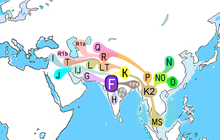
Back المجموعة الفردانية F Arabic Haplogrup F del cromosoma Y humà Catalan Haplogruppe F (Y-DNA) German Haplogrupo F (ADN-Y) Spanish Haplogroupe F French पितृवंश समूह ऍफ़ Hindi Aplogruppo F (Y-DNA) Italian ハプログループF (Y染色体) Japanese Haplogrupa F (Y-DNS) Latvian/Lettish Хаплогрупа F-M89 Macedonian
| Haplogroup F-M89 | |
|---|---|
 | |
| Possible time of origin | 57,500–62,500;(Raghavan 2014);[1] 45,000–55,700 BP (Karafet 2008);[2] 43,000–56,800 BP (Hammer & Zegura 2002).[3] |
| Possible place of origin | West or South Asia[4][5][6][7] or Southeast Asia[8] |
| Ancestor | CF |
| Descendants | Primary: F1, F2, F3, GHIJK. |
| Defining mutations | M89/PF2746, L132.1, M213/P137/Page38, M235/Page80, P14, P133, P134, P135, P136, P138, P139, P140, P141, P142, P145, P146, P148, P149, P151, P157, P158, P159, P160, P161, P163, P166, P187, P316 |
Haplogroup F, also known as F-M89 and previously as Haplogroup FT, is a very common Y-chromosome haplogroup. The clade and its subclades constitute over 95% of paternal lineages outside of Africa.
The vast majority of individual males with F-M89 fall into its direct descendant Haplogroup GHIJK (F1329/M3658/PF2622/YSC0001299).[9] in addition to GHIJK, haplogroup F has three other immediate descendant subclades: F1 (P91/P104), F2 (M427/M428), and F3 (M481). These three, with F* (M89*), constitute the paragroup F(xGHIJK). They are primarily found throughout South Asia, Southeast Asia and parts of East Asia.
Haplogroup GHIJK branches subsequently split into two direct descendants: G (M201/PF2957) and HIJK (F929/M578/PF3494/S6397). HIJK in turn splits into H (L901/M2939) and IJK (F-L15). The descendants of the haplogroup IJK include the clades I, J, K, and, ultimately, several major haplogroups descended from Haplogroup K, namely: haplogroups M, N, O, P, Q, R, S, L, and T.
- ^ Estimated time that F split from C = 70,000–75,000 BP; estimated time when G split from HIJK = 45,000-50,000 Raghavan, M.; et al. (2014). "Upper Palaeolithic Siberian genome reveals dual ancestry of Native Americans". Nature. 505 (7481): 87–91. Bibcode:2014Natur.505...87R. doi:10.1038/nature12736. PMC 4105016. PMID 24256729.
- ^ Cite error: The named reference
Karafet2008was invoked but never defined (see the help page). - ^ Cite error: The named reference
Hammer & Zegura 2002was invoked but never defined (see the help page). - ^ Kivisild et al 2003, The Genetic Heritage of the Earliest Settlers Persists Both in Indian Tribal and Caste Populations
- ^ Sengupta et al 2005, Polarity and Temporality of High-Resolution Y-Chromosome Distributions in India Identify Both Indigenous and Exogenous Expansions and Reveal Minor Genetic Influence of Central Asian Pastoralists
- ^ Sanghamitra Sahoo et al 2006, A prehistory of Indian Y chromosomes: Evaluating demic diffusion scenarios
- ^ Arunkumar et al 2012
- ^ Hallast, Pille; Agdzhoyan, Anastasia; Balanovsky, Oleg; Xue, Yali; Tyler-Smith, Chris (2020-07-14). "A Southeast Asian origin for present-day non-African human Y chromosomes". Human Genetics. 140 (2): 299–307. doi:10.1007/s00439-020-02204-9. ISSN 1432-1203. PMC 7864842. PMID 32666166.
- ^ ISOGG, 2015, Y-DNA Haplogroup F and its Subclades - 2015 (8 September 2015).